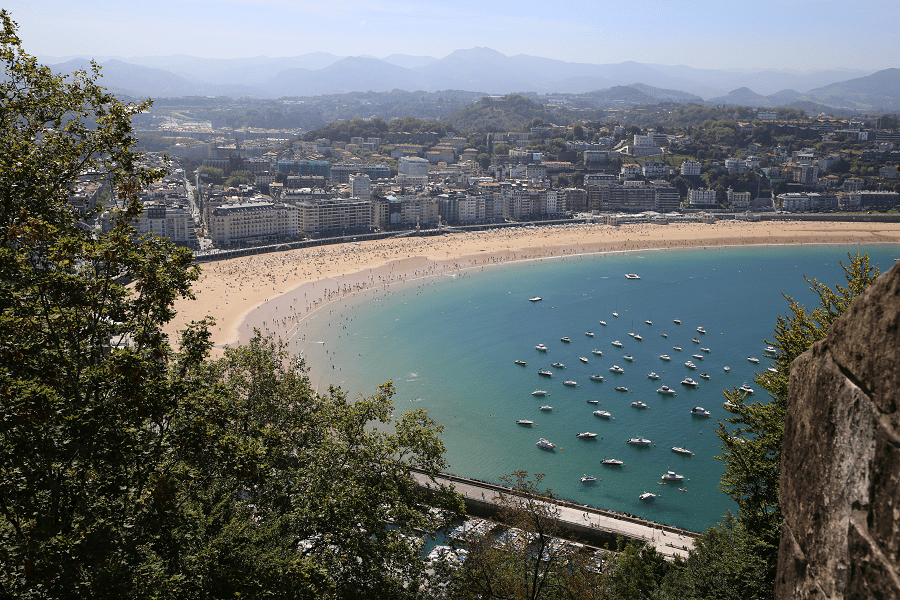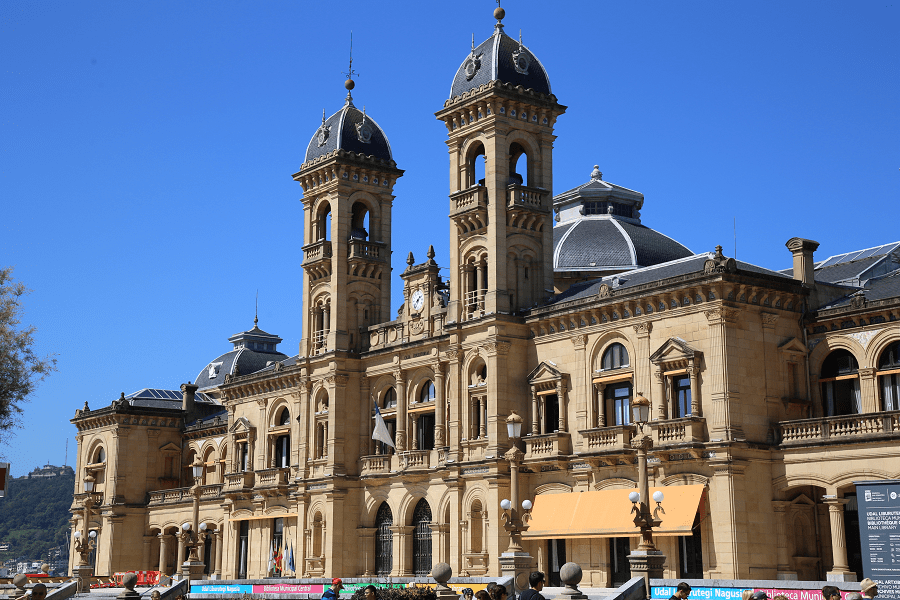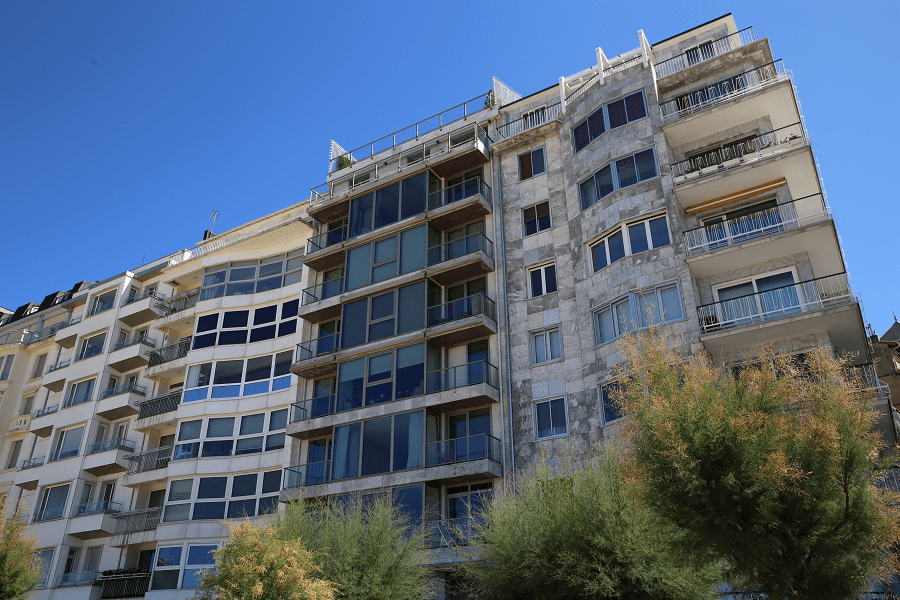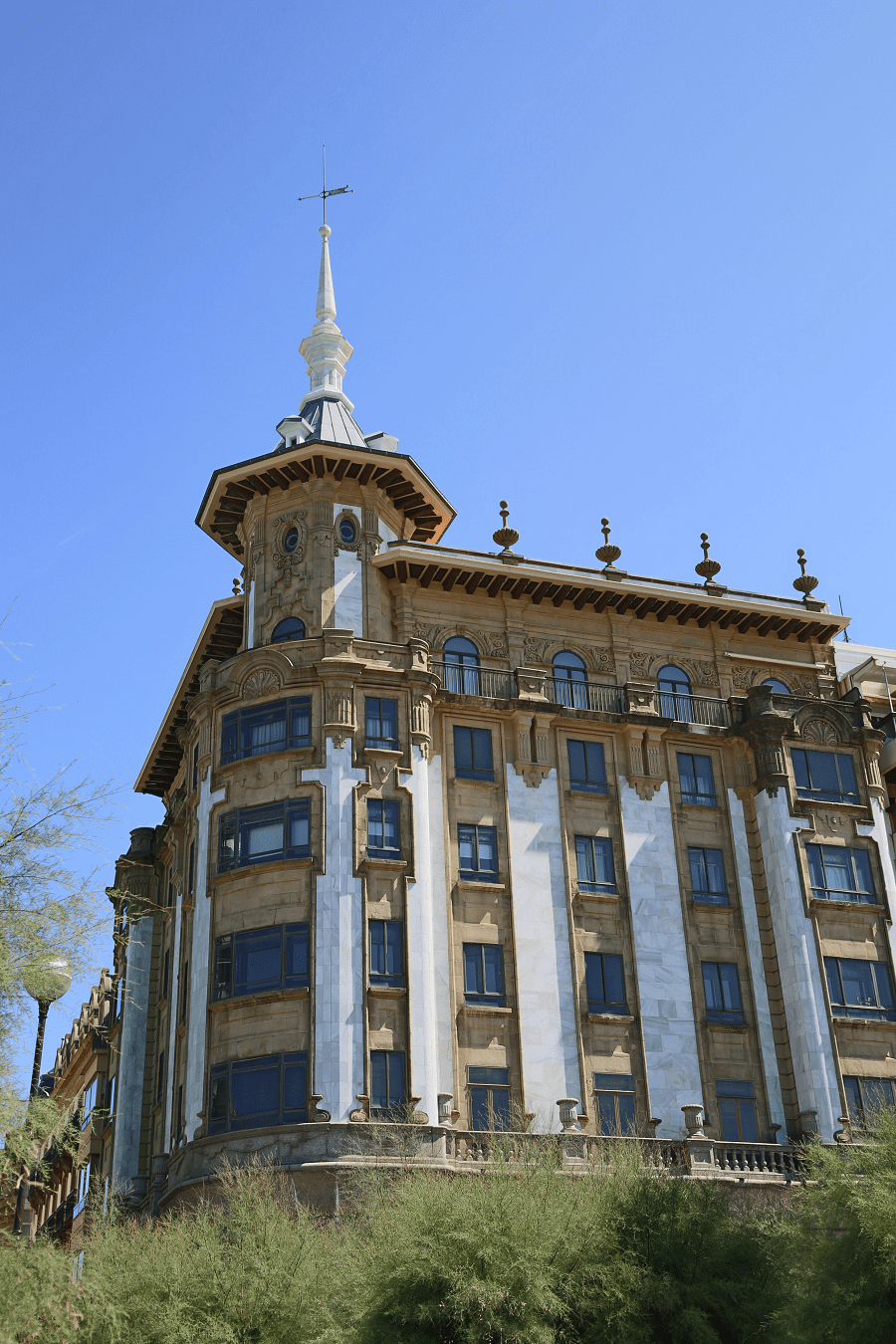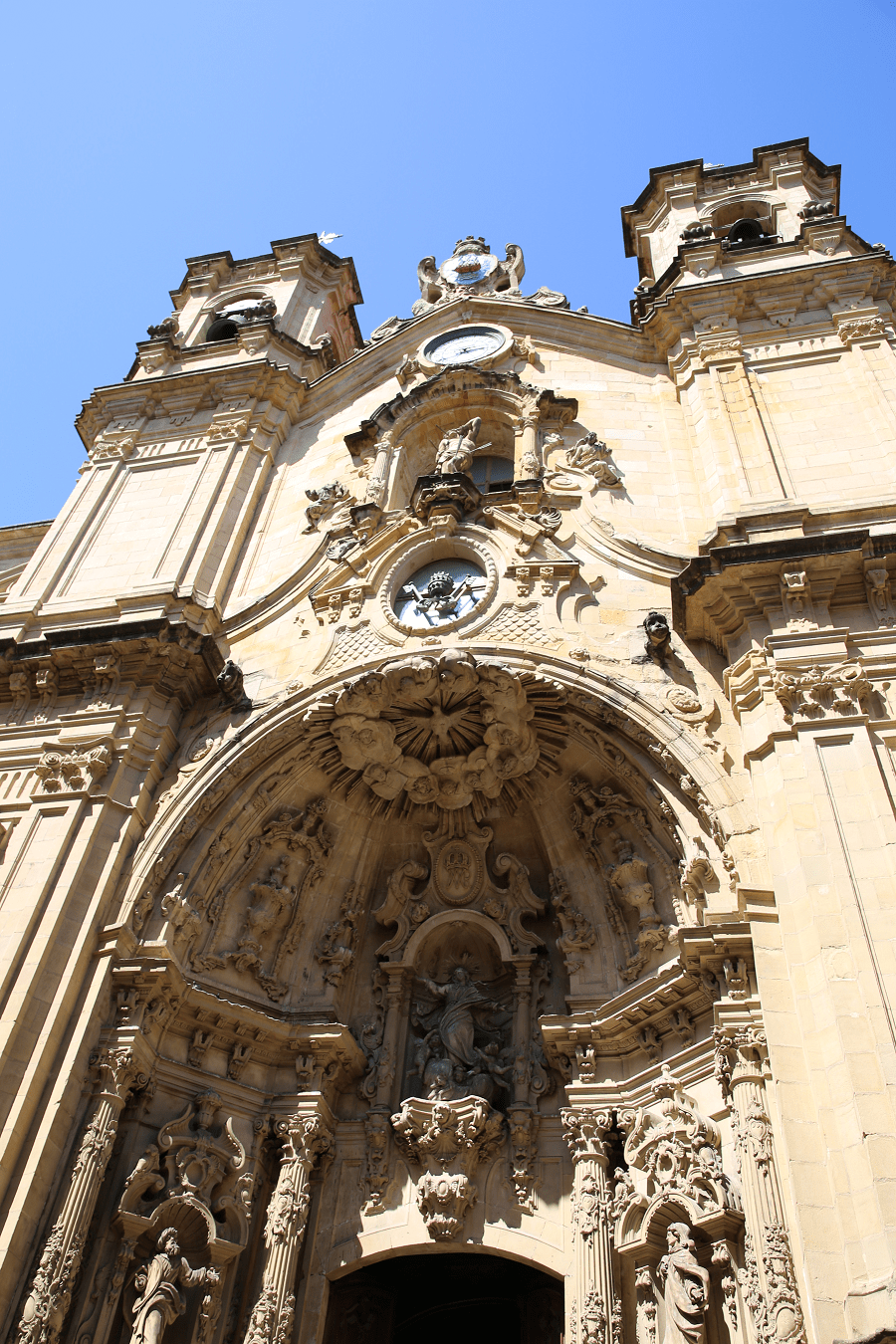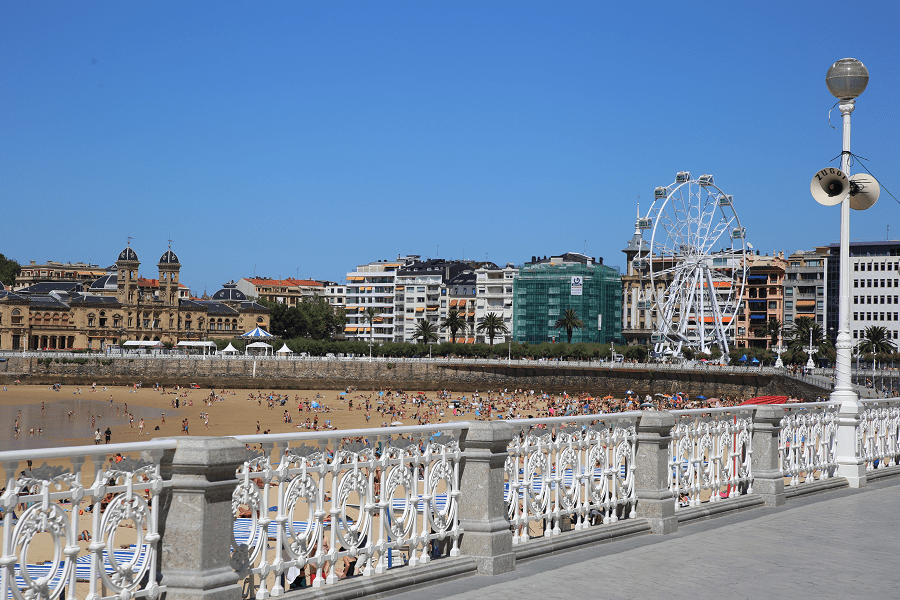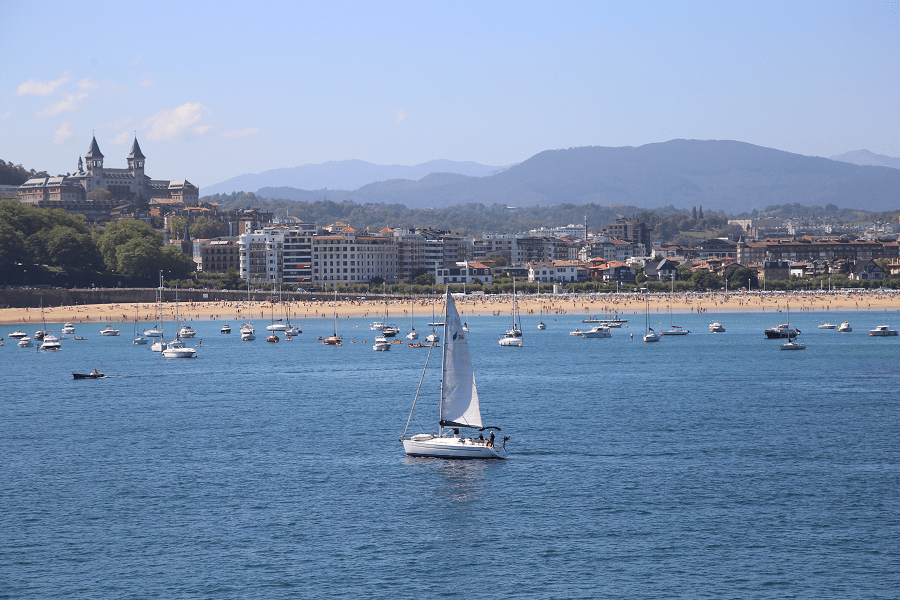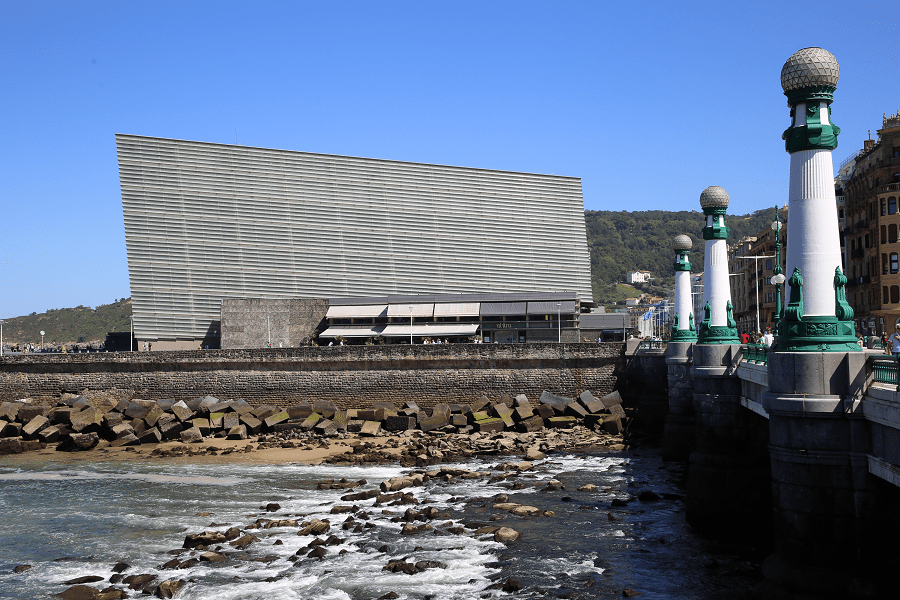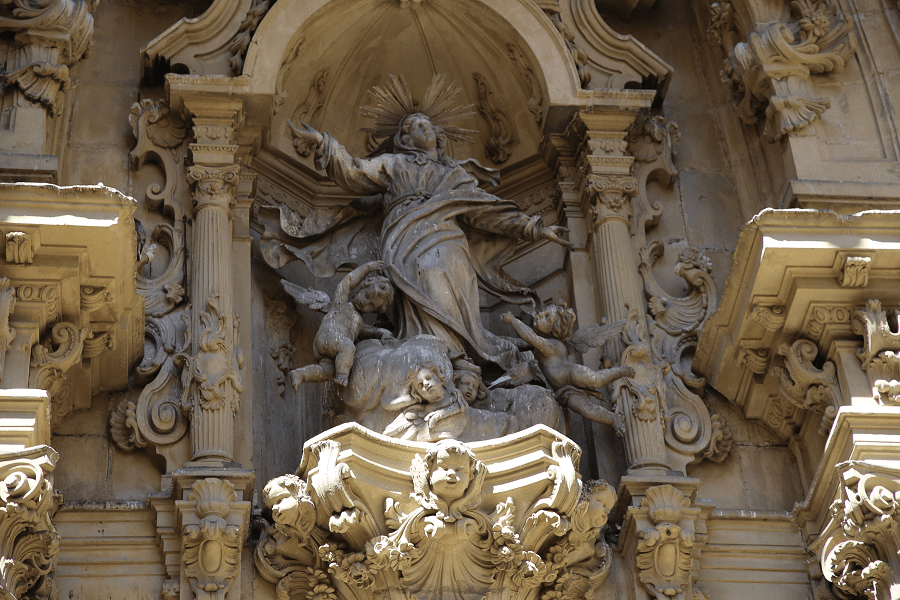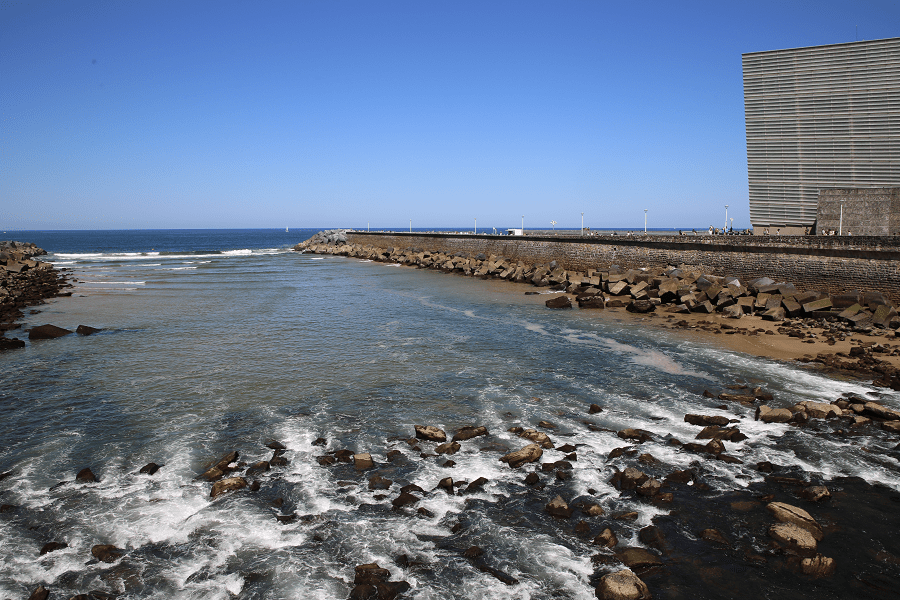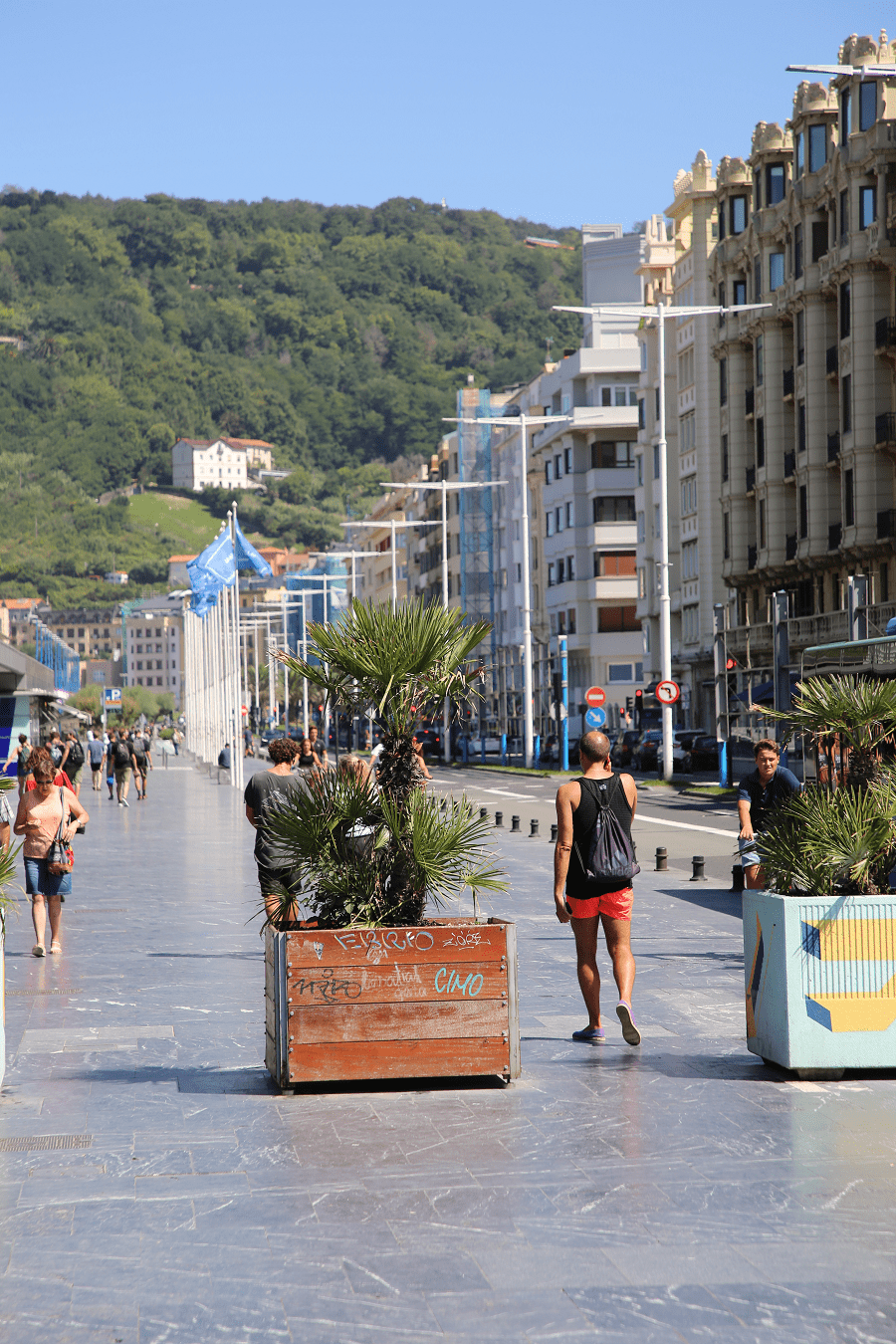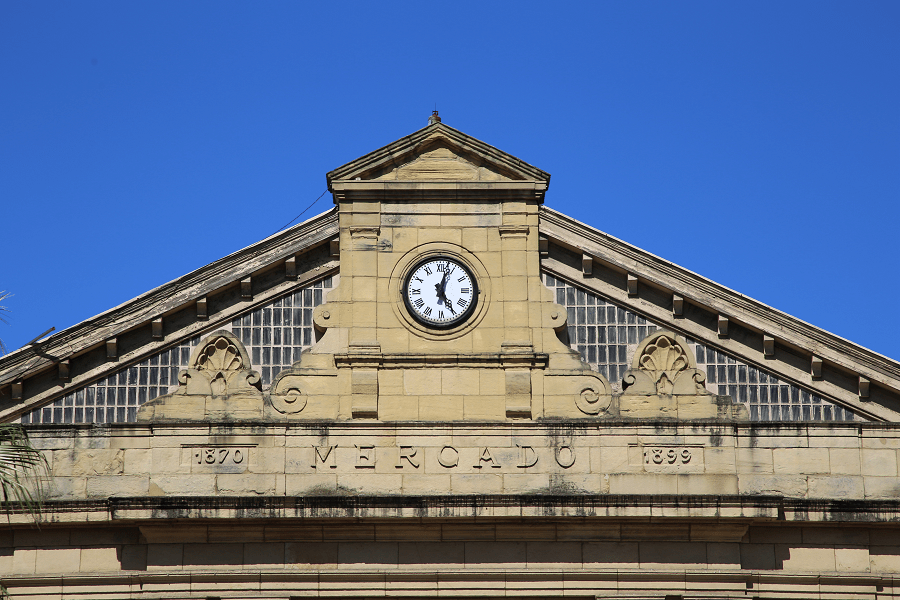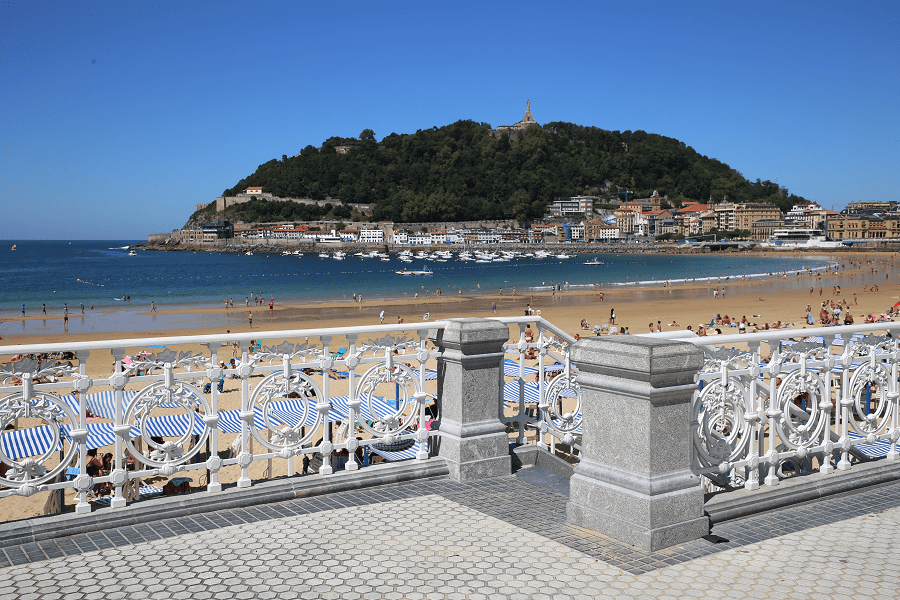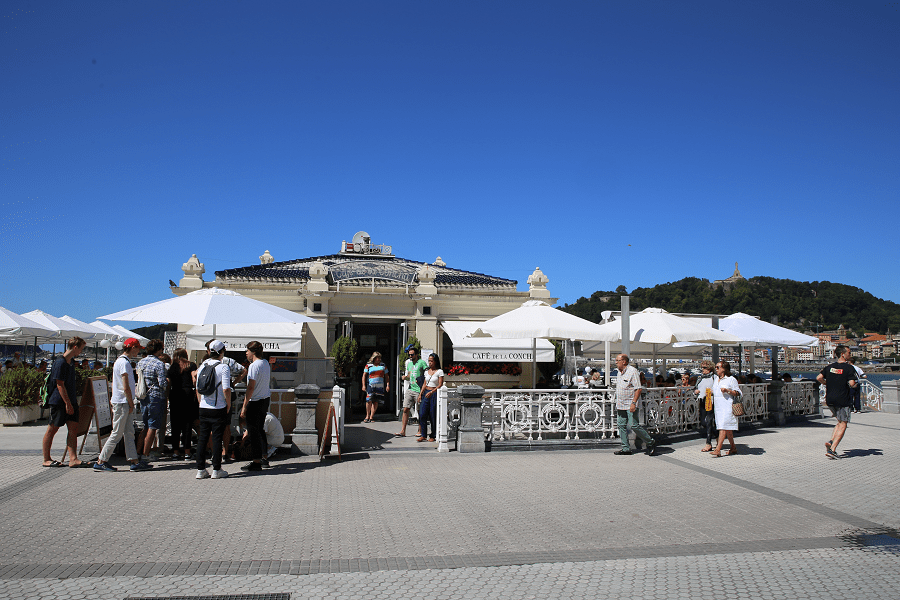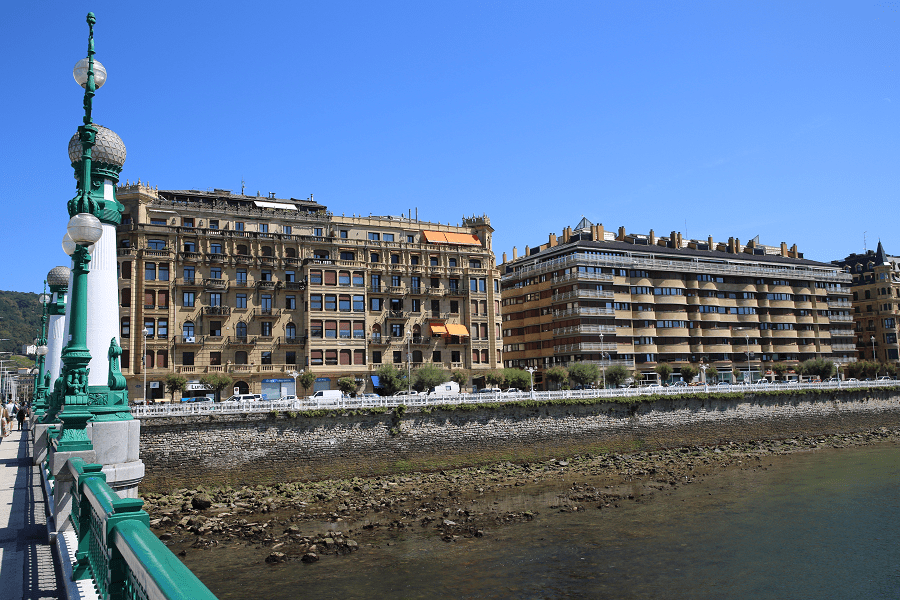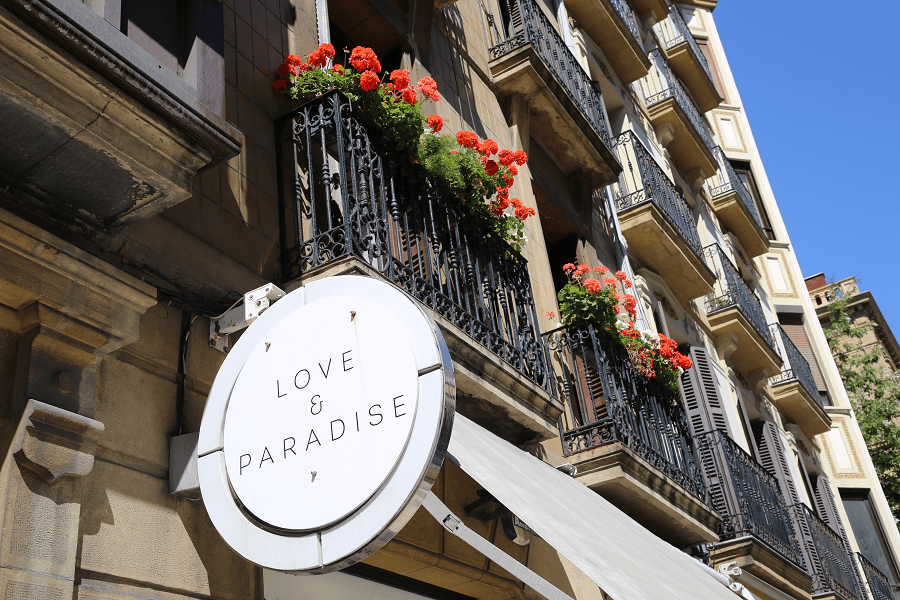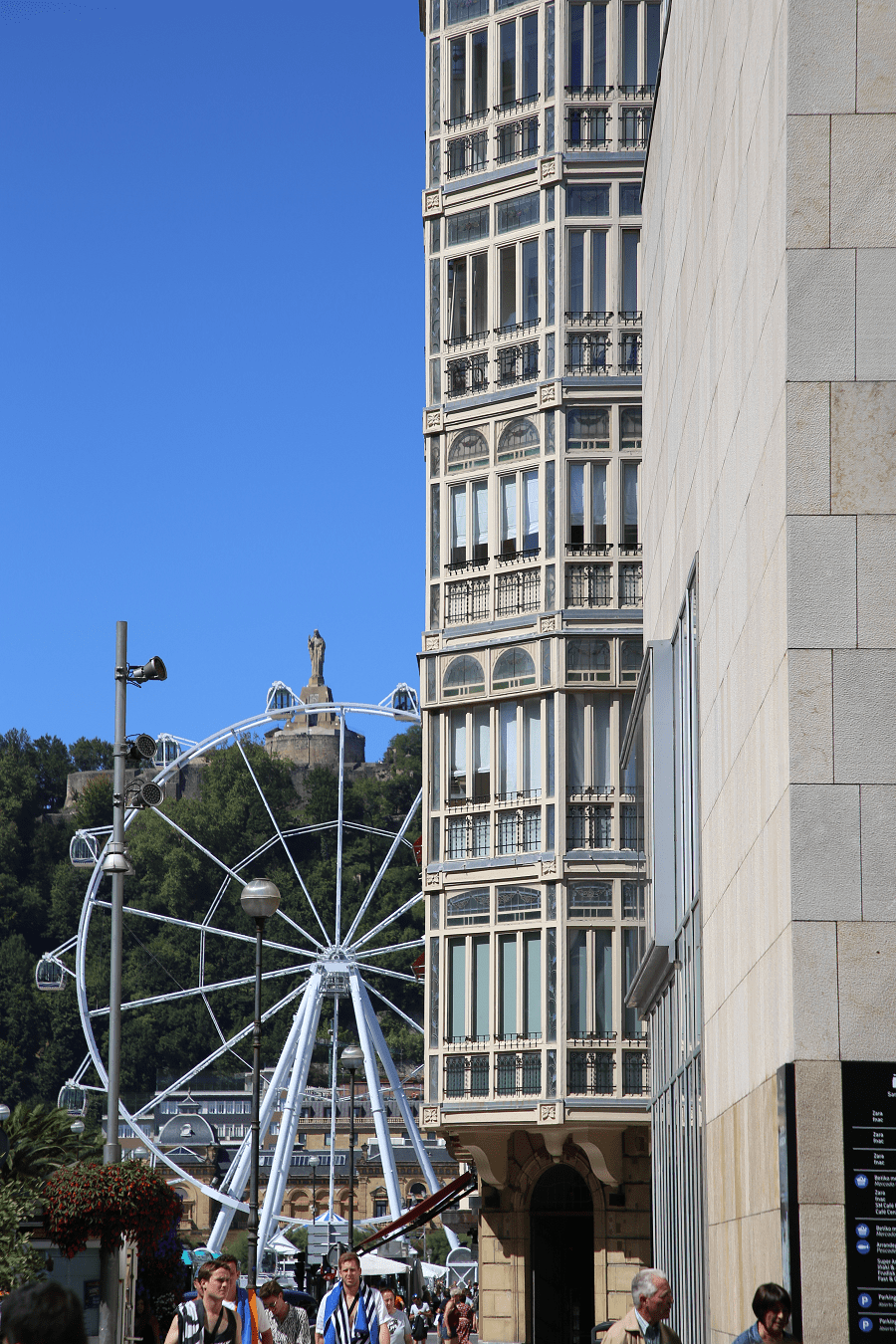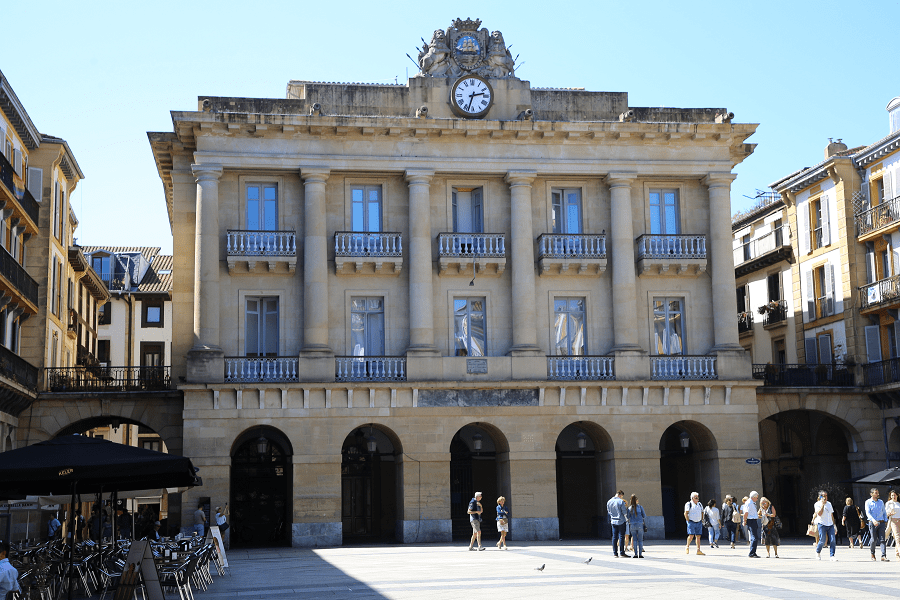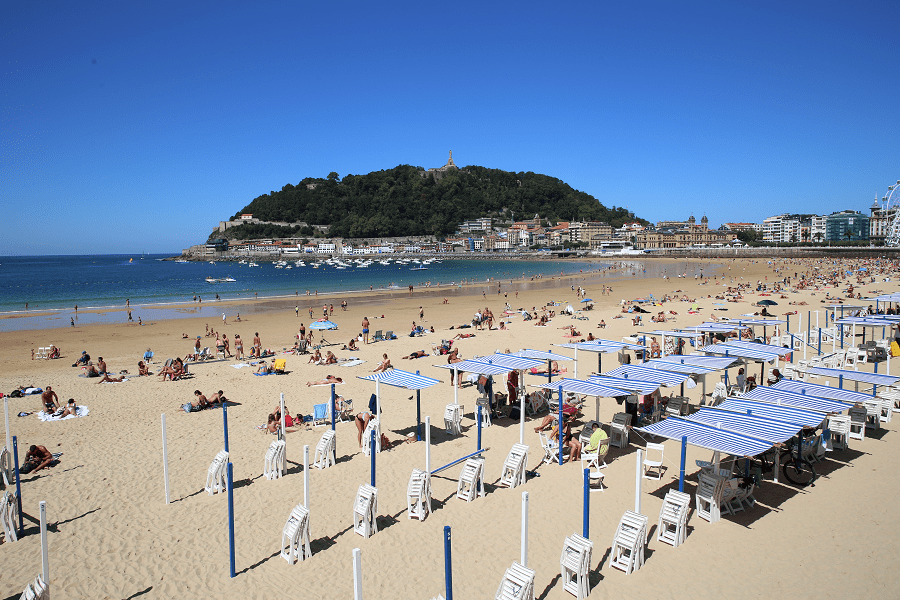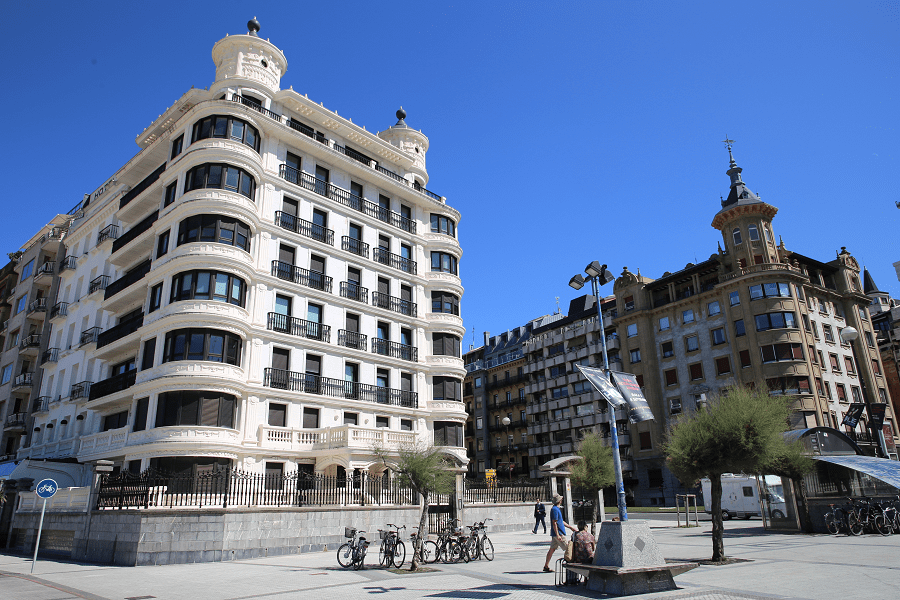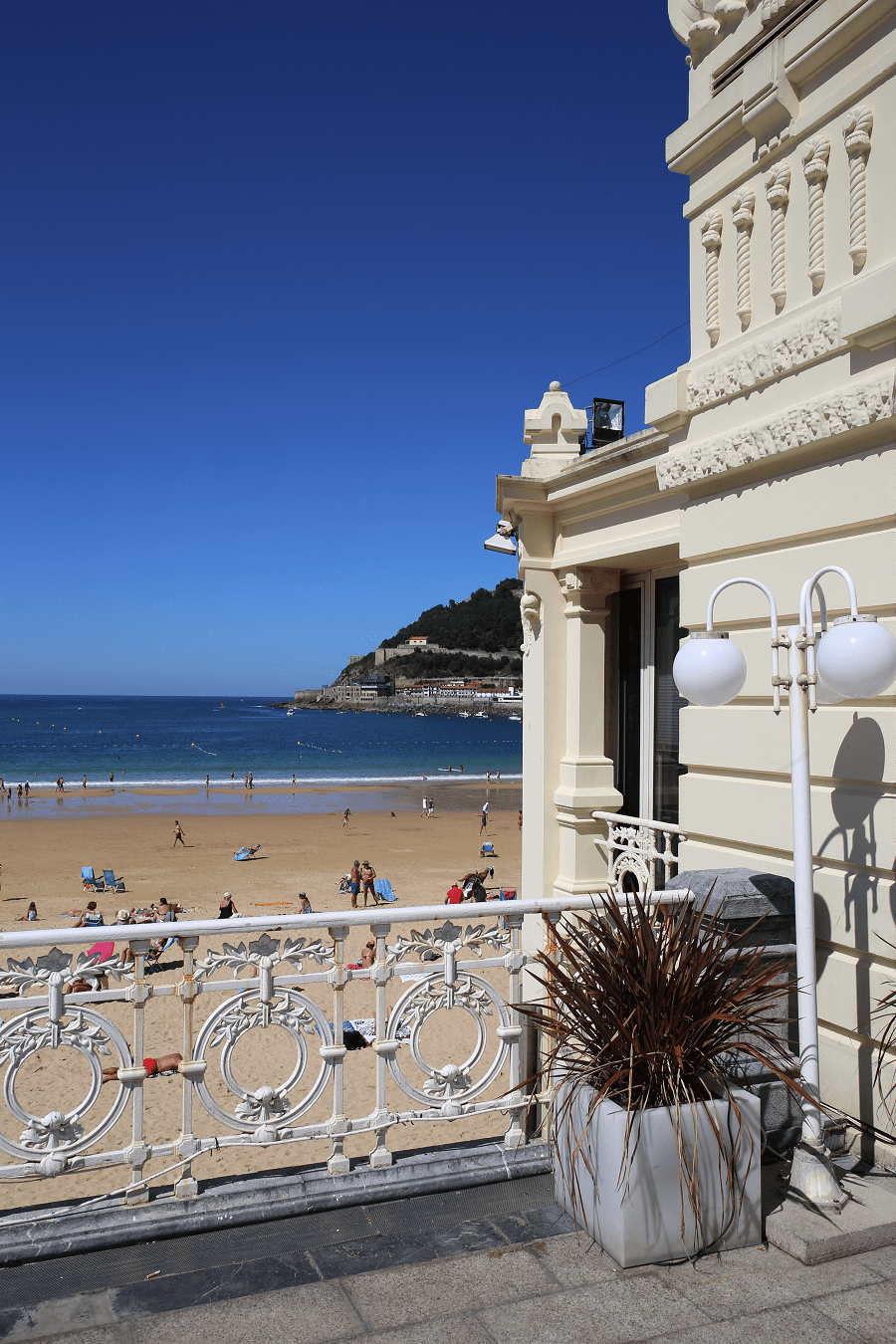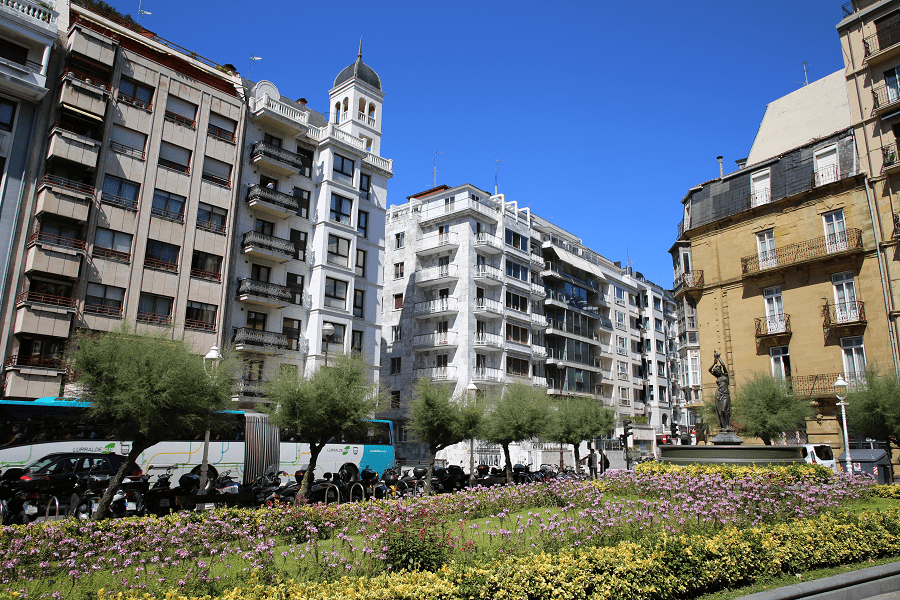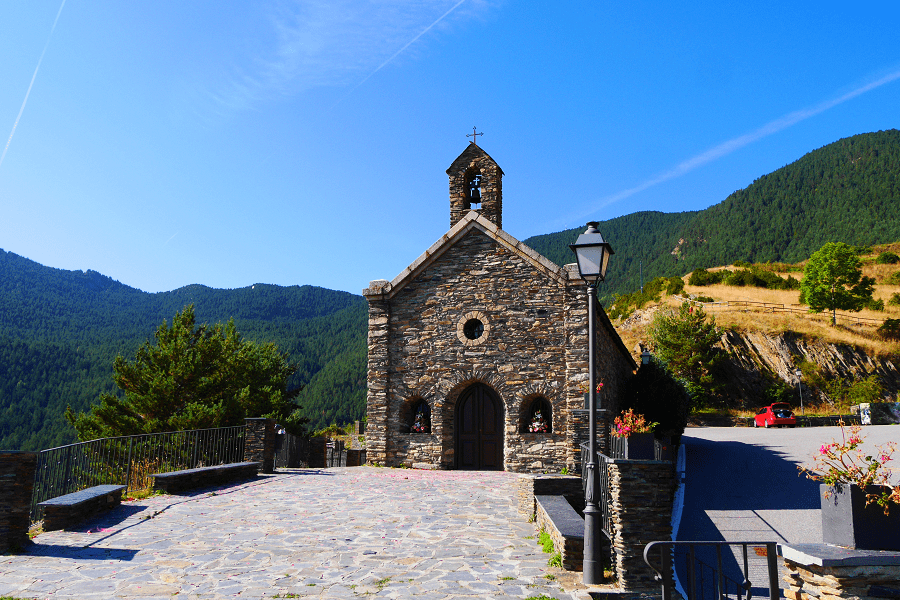San Sebastián (or Donostia in Basque) is a coastal city and municipality, the capital of the Gipuzkoa province, and is located in the Basque Autonomous Community, in northern Spain. The city is located on the southern coast of the Bay of Biscay, 20 km from France. The population of San Sebastian’s municipality is 186,665 people (according to the data for 2020), and 436,500 people live in the entire San Sebastian comarca (as of 2019).
A resident of Donostia is called a Donostiarra, in both Spanish and Basque. The Basque version of the city’s name – Donostia – has the same meaning as in Spanish – “Saint Sebastian”. The dona/done/doni element in Basque place-names signifies “saint” and is derived from the Latin domine; the second part of Donostia contains a shortened form of the saint’s name.
Donostia’s main economic activities are commerce and tourism, and it is one of the most popular tourist destinations in Spain. Despite San Sebastián’s small size, the important International Film Festival is one of the biggest art events. San Sebastián, along with Wroclaw, Poland was the European Capital of Culture in 2016.
A popular part of the Costa Vasca (Basque Coast) of the Atlantic resorts of Spain.
San Sebastian’s three picturesque beaches are La Concha, Ondarreta and Zurriola. The city is surrounded by easily accessible mountains: the 123-meter Urgull (near the city’s old part), the small Uliya mountain range (extending east to Pasaia), Mount Adarra (in the southern part of the city) and Igeldo mountain (in the western part).
Due to the fact that San Sebastian aimed towards developing its tourism sector, Mount Urgull ceased to be used by the military and was sold by them to the city council in 1924. Most of the mountain surface is covered with trees and the remaining military fortress at the top looks very picturesque, recalling the turbulent events of previous centuries.
There is a small history museum in the fortress’ premises which is part of the larger San Telmo Museum (San Telmo Museoa), located on the southeast slope. There are beautiful views of the bay and the city from the top of Urgull.
Located at the Urumea River mouth, Donostia in its present form was built over the past two centuries, mainly on marshy lands. In fact, the city center and the Amara Berri and Riberas de Loiola districts stand on the former riverbed which was launched through its current canal in the first half of the 20th century.
The most popular view of San Sebastian is that of La Concha Bay, in which the city itself is surrounded by mountains. A small but very picturesque Santa Clara island grew up in the middle of the bay.
San Sebastian transport and logistics
San Sebastian is serviced by «Euskotren Trena», the main Basque Country railway operator. «Euskotren Trena» operates trains to Bilbao and other destinations, as well as the Donostialdea Metro in San Sebastian. The city has its own airport, which is located in the neighboring municipality of Fuenterrabia (Hondarribia).
Metro Donostialdea serves the city of San Sebastian and the Donostialdea district, which is part of the San Sebastian comarca within the Gipuzkoa province and reaches the French city of Hendaye near the Bay of Biscay. The metro line was first opened in Donostia in 1912 as a regional train connecting San Sebastian with the city of Irun. The “Feve” Spanish narrow-gauge railway company owned the metro for a long time until in the 1970s the metro passed to the Basque government – then it, along with other narrow-gauge lines, was transformed into “EuskoTren”.
The Metro Donostialdea network has currently only one line connecting the city of Lasarte-Oria with San Sebastian, Pasaia, Irun, and Hendaye. The possible expansion of the network in the future is being considered – it is planned to build seven new stations.
The city bus is the main form of public transport in San Sebastian. The local bus network of 30 lines covering the entire city has been served by Compañía del Tranvía de San Sebastián (CTSS) under the Donostia Bus commercial name since 1886. The city bus use per capita in San Sebastian is the highest in Spain.
Two companies represent rail transport in San Sebastian: EuskoTren and Renfe.
Trains to Madrid, Barcelona, and A Coruña depart from the North Station several times a day. Renfe Cercanías trains connect San Sebastian with towns in Gipuzkoa.
Another means of transport, as well as a city landmark, is the funicular, opened in 1912 and connecting Ondarreta Beach with an amusement park on the top of Mount Igeldo. In addition, San Sebastian has numerous elevators, escalators, and mechanical ramps to facilitate residents’ movement in the highlands, which make up 50% of the city’s population. Donostia takes 4th place in Spain in terms of developing vertical accessibility for the disabled (lifts, elevators, etc.), followed by Barcelona, Bilbao and Eibar.
San Sebastian has a developed network of bike paths, the length of which exceeds 56 kilometers. They are called “bidegorri” here, which in Basque means “red path” – reflecting the color of the bike path. The use of a bicycle as a vehicle is growing rapidly among citizens, and the city authorities plan to expand the network so that you can freely cycle around the city. Now the network of bike paths reaches neighboring municipalities (Lasarte-Oria, Pasajes, and Astigarraga), connecting with their own bike paths.
San Sebastian airport
The San Sebastian Airport runway extends along the Bidasoa River, right on the Spanish-French border. The potential renovation project provides for an extension of the runway to meet the requirements for larger aircraft servicing. However, these plans still cause numerous disputes and resistance from opposition-minded citizens; to this are added the economic difficulties faced by air carriers using the terminal. All this makes the airport’s future even more uncertain.
San Sebastian Airport serves domestic flights, the most regular of which are to Madrid and Barcelona. One can only fly with transfers from Russia to San Sebastian. In addition, due to the small number of flights, tickets can be much more expensive than when arriving at other airports. In this regard, in order to save money, we recommend choosing the nearest terminals, for example, Bilbao Airport (100 km from San Sebastian) or the airport of the French city of Biarritz (Biarritz Pays Basque Airport), which is 48 km from Donostia. There will be transfers in this case also, but there is the possibility of choosing flights and saving money.
Many tourists prefer to fly to major Spanish airports (Barcelona, Madrid, Alicante), and then travel to San Sebastian by train, bus or domestic Spanish low-cost airline (for example, by Vueling).
If you prefer to travel by train, then you can take the train from Moscow or St. Petersburg to Paris, and go from Paris to Hendaye, which is located on the border with Spain. There are regular electric trains from Hendaye to San Sebastian.
Ouibus buses run from Biarritz Airport to San Sebastian several times a day. The fare will be 5-7 euros; travel time – 1 hour 10 minutes. SNCF trains go from the terminal to Hendaye, where you will need to go to another station and catch the Euskotren train to San Sebastian.
A car trip takes about half an hour.
If you arrive at the San Sebastian airport, then you can get from the airport to the city both by bus and by train. Lurraldebus buses travel about every half an hour to the city center. Buses run every hour; the fare is about 2-4 euros.
Euskotren trains leave from the airport quite often also and arrive at San Sebastian in 35 minutes. The fare is 2-3 euros.
A car or taxi trip takes 15-20 minutes.
San Sebastian’s landmarks. Tourism and main sights
The main San Sebastian promenade is located by La Concha bay. There is the beach of the same name, along which stretches a picturesque promenade with rows of trees, benches and a beautiful white balustrade. It is good to walk day and evening, admiring the beautiful views of the bay and the Santa Clara island and admiring the sunsets and the promenade with its cozy lighting in the dark.
The small rocky island of Santa Clara is a local attraction, an indispensable attribute of all tourists’ photographs. The island itself can be reached by boat, cruising from the port during the summer season.
La Concha Promenade (Playa de La Concha) is in fact, the main tourist street, at the beginning of which is San Sebastian’s City Council building (Ayuntamiento de San Sebastián). Donostia’s main casino, constructed in 1887, was located here previously. Queen Mary Christina of Austria herself honored the opening ceremony with her presence. However, in 1924 a ban on gambling was introduced and the institution was closed. The city council moved here in 1945.
There is the Miramar Palace (Palacio de Miramar) at La Concha Bay, the construction of which was commissioned by the royal family in the late 19th century.
The close relationship between Donostia and the Royal Spanish Crown began with Isabella II of Spain, who began spending the summer here in the mid-19th century to be able to take sea baths regularly. These ties were further strengthened when Maria Cristina of Austria, wife of Alfonso XII, became a widow and began to spend the summer months in San Sebastian. The Royal Summer Residence was required in this regard, and Maria Christina ordered its construction to the English architect Selden Wornum. They chose a large estate for the palace over La Concha bay, where the San Sebastian El Antiguo monastery was located.
The palace’s construction was completed in 1893, and in 1920 another structure was added under the “Pabellón del Príncipe” (“Prince’s Pavilion”) name.
In 1929, the palace passed to Alfonso XIII, the son of the deceased Maria Cristina, but already in 1931, during the Second Spanish Republic, the government confiscated it. Two years later, Miramar passed into the hands of Donostia’s city council with the condition that it will continue to serve as a summer residence for the President of the Republic, and part of its premises will be used for educational and cultural purposes. After Franco came to power, the Miramar Palace was returned to the property of Alfonso XIII’s children, mainly don Juan de Borbon.
San Sebastian’s city council nevertheless redeemed the Miramar Palace in 1972, and it is open to the public now with its beautiful gardens. Important receptions and events are held in the palace gardens and halls, for example, for the International Film Festival in San Sebastian. Miramar Palace Hotel hosts Basque Country University Summer Courses.
Fortunately, the exterior of Miramar Palace, made in a purely English style with a small amount of neo-Gothic decorations, has been preserved in its original form. Inside, the original majestic halls have been preserved, such as the White Hall, the Wooden Hall, the Petit Salon, the Library and the Royal Dining Room. The rest of the Palace has been renovated successively since it was acquired by the City Council, making it more functional. The last works were conducted in 2001 to build classrooms for «Musikene» (Higher School of Music of the Basque Country), and in 2007, the tower of the Palace was refurbished.
If you want to see personally the famous “postcard” view of La Concha bay and the city of San Sebastian spread out between the mountains, you need to go up to the observation deck located on Igeldo mountain (Monte Igueldo). You can have a great time on the mountain as there is an amusement park too which opened in 1925. If you travel around the city on foot, then it is quite possible to climb Igeldo on your own. But those who wandered around San Sebastian all day and were pretty tired can take the funicular boarding at the end of Ondarreta Beach.
Another significant mountain – Urgull (Monte Urgull) rises right in the city center; there is a giant statue of Jesus Christ (over 12 meters high) at its top. In general, the park area on Mount Urgull is very pleasant to walk around especially on a hot sunny day. At the same time, there are several hiking routes for climbing the mountain of varying difficulty, from which you can choose the most suitable. And historical building lovers will be able to explore the remains of the medieval fortress of La Mota (Castillo de la Mota), as well as visit the city’s history museum located here for free. The fortress observation platforms offer stunning panoramic views.
There is the popular Zurriola Beach on the other side of the Urumea River – a place that is considered more democratic and not as pathos as La Concha. There is also a promenade from which you can watch the many surfers.
Traditionally, a variety of events and festivals are held on Zurriola, including concerts of the Jazzaldia International Jazz Festival.
Here is also located one of the most famous and iconic buildings of San Sebastian – the Kursaal Congress Centre and Auditorium.
Kursaal Congress Centre and Auditorium (Palacio de Congresos-Auditorio Kursaal) is a complex comprising of several spaces: a great auditorium, 1,800-seat concert hall, exhibition halls. Kursaal was opened in 1999 and was designed by Spanish architect Rafael Moneo. In 2001, the congress center was awarded the European Union Prize for Contemporary Architecture. The San Sebastián International Film Festival takes place here. The present “Kursaal” stands on the site of the former “Great Kursaal” elegant palace, which was erected in 1921 but was demolished in 1973. The former palace housed a casino, restaurant, cinema, and theater.
The modern Kursaal building consists of two large prisms erected on a single base. The facade of each prism or “cube” is made of translucent glass panels laid on a metal frame. There is a terrace between the large and small cubes overlooking Zurriola beach. The Donostia Jazz Festival (“Jazzaldia”) concerts are held here like on the beach itself, as well as many other events.
The main concert hall is located in the large cube closest to the sea, and large-scale events are held here also, such as the International Film Festival. If space is required for the orchestra, the front rows of seats in the concert hall can be removed easily.
There is a chamber hall for 600 seats in the small cube. It mainly hosts small concerts, congresses, and conferences.
The impressive bright and constantly changing Kursaal night illumination creates a unique city look and a special atmosphere.
Near Kursaal, the Zurriola bridge (Puente la Zurriola) spanned across the river with very spectacular lampposts designed by Victor Arana in the Art Deco style.
Among other San Sebastian contemporary architecture masterpieces, it is also worth mentioning the 2011 Basque Culinary Center building and the Higher School of Music of the Basque Country – Musikene (2016).
The Basque Culinary Center, resembling a stack of giant plates, is located in Miramon Technology Park.
Musikene Music School, located in the Benta Berri district, is a large black piano-lacquered building of modern shapes with a golden roof – a kind of reference to the colors of musical instruments.
One of the main historical symbols and attractions of San Sebastian is the Maria Cristina Bridge (Puente de María Cristina) over the Uruméa River. Prior to the construction of this bridge in 1893, a temporary wooden bridge was located on this site, across which residents could easily get from downtown to the North Station and the bullfighting arena.
The current bridge was opened on January 20th, 1905, on St. Sebastian’s Day. It was built from reinforced concrete, which was a novelty for that time, with three arches. It is 20 meters wide and 88 long. Four monumental 18-meter obelisks were erected at the ends of the bridge. They were crowned with sculptural groups – the same as those on the Paris bridge of Alexander III.
There is another symbol of the city in the Amara district – the Cathedral of the Good Shepherd (Catedral del Buen Pastor de San Sebastián, or Artzain Onaren katedrala in Basque), the most outstanding religious building of Donostia and the largest in Gipuzkoa. The construction of this powerful and aspiring temple took place in the last years of the 19th century in a historical neo-Gothic style from the slate and stone of Mount Igeldo. Interestingly, all the workers involved in the construction were Basque.
The Church of the Good Shepherd was officially opened in 1897. Queen Regent Maria Cristina of Austria, her son King Alfonso XIII, and Infanta Maria Teresa of Spain, who laid the first stone at the beginning of construction, were present at the opening ceremony. The cathedral tower was completed in 1899 under the direction of Ramon Cortazar. The temple lancet arches are inspired by the medieval churches of Germany and France, while the slender bell tower located on the entrance portico is inspired by the spires of Cologne Cathedral. The main facade is the “Cross of the World” by the famous sculptor Eduardo Chillida. This work was a gift from the artist to the cathedral, which celebrated its centenary in 1997. A cross carved from a piece of alabaster preserves the original stone texture.
The temple nave height is 25 m, the tower is 75 m, the central nave length is 64 m, and the width is 36 m. The cathedral is able to accommodate 4,000 people. Along with its size, the grandiose stained-glass windows of the cathedral make a great impression. The organ installed in 1954 in the cathedral is the second in the history of the temple. According to data published at the time, it was the largest organ in Spain and one of the largest in Europe.
The temple dedicated to the Good Shepherd received the status of a cathedral in 1953.
The second most important church of San Sebastian is located in the Old Town; it is a very beautiful and elegant Baroque Basilica of Saint Mary of Coro (Basílica de Nuestra Señora del Coro). This is a Roman Catholic parish church with a minor basilica status. It was built in 1774 on the site of an old medieval church.
The main entrance, decorated in Baroque style with references to the Churrigueresque style, is located between the two towers and looks like an altar with the St. Sebastian martyrdom and papal symbols confirming a minor basilica status. The shield of the city crowns the building. Interestingly, the basilica’s main entrance is directly in front of the San Sebastian Cathedral’s entrance.
In general, the Old Town is divided into two parishes belonging to two churches: the Basilica of Saint Mary and the Church of San Vicente. Residents attending the first church are traditionally called joxemaritarrak, while those belonging to the second church are called koxkeroak. Moreover, koxkeroaks were mainly Gascons until the beginning of the 18th century.
The San Vicente Church is located at the foot of the mountain, at the other end of the same street on which the Basilica of Saint Mary is built. This medieval church, built in the first half of the 16th century, is considered the oldest in Donostia, while its building was part of an ancient fortress in the past. Inside the temple is the magnificent original altar of 1586 by Ambrosio de Bengoechea and Juan de Iriarte. Among the other sights of the church, it is worth highlighting the 1968 French organ by Cavaillé-Coll (a famous craftsman), the impressive stained glass windows, and the “Pieta” sculpture by Jorge Oteiza, located on one side of the facade.
Another impressive sculpture by Jorge Oteiza called “Construcción Vacía” (“Void Construction”) is located on the New Promenade (Paseo Nuevo). This work, which received an award at the Biennale in Sao Paulo half a century ago, is now a benchmark in the field of contemporary art. The sculpture produces the greatest effect during a storm when huge waves hit the embankment.
Speaking about the contemporary sculptural installations of Donostia, one cannot fail to note the famous work of Eduardo Chillida – “Dedication to Fleming”, which stands in the center of La Concha.
Thus, the sculptor paid a personal tribute to the penicillin inventor. The structure was made of iron initially, in 1955, the year the Scottish scientist died. However, in 1990, the artist replaced it with a granite installation.
A 7-meter sculpture of Bakearen Usoa (“Peace Dove”), created in the 80s by the artist Néstor Basterretxea, is installed on Zurriola’s seafront. This dove symbolizes the desire of the city for freedom and peaceful coexistence.
San Sebastian’s museums and parks
San Sebastian’s main museum is San Telmo (San Telmo Museoa, or STM for short) which is a museum about Basque society and citizenship dedicated to traditional and contemporary Basque culture, art and history of the people in the European and world context. Since 1932, it has been located at the Zuloaga plaza in the old town, at the foot of the Urgull hill.
San Telmo is presented as a museum and, at the same time, as a place “to disseminate knowledge and create thought.” Many Basque Country citizens consider it is an instrument to understand the present and build the future from encounters with the past and with Basque society roots.
In 2011, a significant redistribution of museum objects took place. The city authorities expanded the 16th-century convent of Dominican friars of San Telmo. The monastery, built in the Renaissance style, preserved the old church, decorated with canvases by the Catalan artist Jose Maria Sert.
The museum received a Special Mention in the 2013 best European museum contest organized annually by the Museum Forum.
The art funds of the San Telmo Museum consist of paintings and sculptures, 200 of which are on display. The works of universally recognized masters such as El Greco, Sorolla, Ignacio Zuloaga are among them.
The items on display in the permanent exhibition range from a collection of grave-stones included in the section “Signs of Spirituality”, to later items, Muhammad XII of Granada, “Boabdil”s sword or Ignatius of Loyola’s spiritual exercises, to modern objects, such as bicycles, a Seat 600 car, or historic Real Sociedad and Athletic Club Bilbao football jerseys showcased in the “Awakening of Modernity” section.
Besides the permanent exhibition, housed for the most part in the old building complex, the museum hosts temporary exhibitions accommodated in the newly erected facilities.
In the museum inside the church, the “Challenges for Our Society” audiovisual is projected ushering the audience into an itinerary summarizing the key challenges for the Basque society in the near future, i.e. sustainability, interculturality, equality, Europe, and Human Rights.
Tabakalera Museum of Modern Art is located east of Urumea. Once, there was a tobacco factory which gave its name to the museum. The tobacco factory was closed in 2003 after 90 years of operation. The building contains a contemporary art collection, a cinema theatre, a multi-purpose hall, a creative library called Ubik, media labs called Hirikilabs, spaces for art creation, a cafeteria called Taba, a residence for artists, and a four-star hotel, called One Shot Tabakalera House. It also hosts the headquarters of local culture institutions Kutxa Kultur, the Basque Film Archive, the San Sebastián International Film Festival, the Elías Querejeta Film School and the Etxepare Basque Institute.
The Maritime Museum (Museo Naval) is in Donostia’s city port. The museum’s small collection tells the story of the Basque shipbuilding, fishing, and whaling industries.
There is one of the largest city parks – Cristina Enea in the Egia area, behind the station; its area is about 95 thousand square meters. It is an ideal place to disconnect from the bustle of the city without leaving it.
At the end of the 19th century, the park, which occupies the Duke of Mandas’ private lands and is named after his wife, was donated by the duke to the city. There is the Mandas Palace inside the park, which houses the Center for Environmental Resources (Centro de Recursos Medioambientales) now.
Walking along the coast of San Sebastian, do not miss the Miramar Palace gardens. Miramar Gardens smoothly descend from the impressive English-style mansion to the sea with a network of neat gravel paths and flower beds. And although Miramar Gardens are inferior in size to Kristina Enea Park, in popularity among tourists they are ahead of many green areas of the city. The gardens’ special location – on a hill, between the two main beaches, allows you to admire the magnificent views of the bay and the island of Santa Clara, as well as the Miramar Palace itself among the impeccably trimmed greenery. Other beautiful views are from the bay waters to this entire park and palace complex.
Another small English public garden is located in Gipuzkoa Square (Plaza Guipuzcoa), directly opposite the Palace of the Council (El Palacio de la Diputacion). This romantic and charming green space resembles a small English park in the heart of the city. The park is famous for its diverse trees, flowers, and plants, as well as a picturesque pond with ducks and swans.
There is the majestic Aiete Park (Aiete parkea) on the hills west of San Sebastian’s downtown. There is a magnificent neoclassical palace inside the park which was the site of the summer residence of Queen Isabelle II, Queen Victoria of England, Queen Mary Christine, and King Alfonso XIII before the Miramar Palace was built. From 1941 to 1975, Aiete Palace served as the dictator Franco’s summer residence. Here is the House of Peace and Human Rights now.
The famous French gardener Pierre Ducasse designed all four parks.
The most outstanding feature of the Ametzagaina Park (Parque Ametzagaina), which stretches over the hills between Otxoki Street on one side and Loiola District on the other, is its size. The park’s area of 380,000 square meters makes it the largest city park in San Sebastian. We can say that this is a real forest in the city with vast groves of leaf-bearing trees and meadows. The park’s highlight is the surviving remains of an ancient fort which dates back to the Carlist Wars.
In the vicinity of the Ulia mountain, there is the eponymous Park of Nurseries of Ulia (Parque de Viveros de Ulía), with a size of more than 14,500 square meters. It is named Flower Garden also on account of the nurseries held inside, which provided the plants for the Donostia public gardens during the 20th century. Ulia Mountain Park is of great value – there are two ancient deposits of water (Soroborda and Buskando) and interesting architectural elements on its territory; the specific flora and fauna inhabit the park.
In its monthly organized sessions in the park by Seo/BirdLife of Donostia, the members of this association have observed up to 32 bird species, which live in the Ulia Park, including red kite, red-hawk, common buzzard, big spotted woodpecker, ringed dove, songbird, and red-headed kinglet (the park’s symbol).
At least 39 species of trees grow in the park, most of which were brought from other countries and continents. Among them are trailing abutilon, bamboo, bougainvillea, Cordyline, wintercreeper, noble laurel, boxwood, Fuchsia Magellanica, cherry plum, cherry laurel, yew tree, oleander, sycamore tree, crepe myrtle, privet, plantain, fatsia japonica, magnolia, jasmine, acanthus, Canary date, fig, thuja, and cedar.
Amphibians such as common midwife toad, salamander, and newt live at the ponds in the park.
South of the Ulia Park, on the coast, is the Donostia Aquarium with a glass tunnel through which a wide variety of fish swim, including predatory sharks, stingrays, and jellyfish. Representatives of the Bay of Biscay (Cantabrian Sea) waters and tropical seas live in over 30 aquariums. You can also see an incubator where shark and stingray eggs are grown, and watch films about underwater inhabitants. In addition to the aquariums themselves, the complex includes a museum of oceanography, which interestingly covers the Basque seafaring and fisheries history. Full admission costs 13 euros.
San Sebastian’s beaches
The attractive San Sebastian coastline, interspersed with picturesque mountains, has given several beautiful beaches for the city residents and guests. All Donostia’s beaches are of golden sand and equipped with the most necessary things – toilets, changing cabins, beach equipment rental, as well as numerous bars and cafes.
Perhaps the main beach of Donostia and the most popular one is La Concha central beach, which stretches for almost 1.5 kilometers. Located directly in the bay of La Concha and thus protected from strong waves, it gives its visitors a wonderful vacation and stunning views.
There is the 600-meter Ondarreta Beach (Playa de Ondareta) between Miramar Palace and Mount Igeldo. This beach is also calm, wide and clean, very suitable for a relaxing family vacation.
You can’t say the same about Zurriola beach, which is located 800 meters on the other side of the Urumea river – it is almost always windy here, because of which active sea sports lovers choose it, especially surfers. In this regard, there are rental points for surf equipment and a school for training in this sport on the beach. In addition, various cultural events and concerts are often held on Zurriolla.
San Sebastian’s cuisine and gastronomy. Michelin star restaurants
Donostia is famous for its Basque cuisine. There are a great number of quality and famous restaurants in San Sebastian and its environs, including restaurants with Michelin stars, for example, Arzak (San Sebastian), Berasategui (Lasarte), Akelarre (Igeldo district), and Mugaritz (Renteria). San Sebastian is the second city in the world with the largest number of Michelin stars per capita, in this, it is second to the Japanese city of Kyoto only. In addition, two of the ten best restaurants in the world are located in San Sebastian according to ratings from 2013.
The main traditional dishes of Basque cuisine are meat and fish cooked on the grill and on hot coals, marmitako (originally Basque tuna and potato dish) and lamb, stew, cod, Tolosa black beans, paprika from Lekeitio, pinchos (Basque tapas), Idiazabal cheese, Chacoli slightly sparkling wine, and Basque cider.
As the Basque Country is divided into coastal and mountainous parts, the cuisine has a lot of variety. Fish and seafood predominate in coastal cuisine, while meat, vegetables, legumes, freshwater fish and salt cod dominate in the continental cuisine. The French and Spanish influence on both sides of the Basque border is also noticeable.
Jews once expelled from Spain and Portugal, set up the production of chocolate and confectionery in Bayonne, known until now, and part of the rich Basque pastry tradition. Basque meals often include tomatoes and sweet or hot red peppers. Paprika is often used in ham, sausages and many other dishes. Olive oil is more commonly used than vegetable oil in Basque cooking.
In the 1970s and 1980s, Basque chefs were influenced by the nouvelle cuisine of France and created the nouvelle Basque cuisine, radically original in its form but solidly Basque in substance, with lighter and less rustic versions of traditional dishes and flavors. In more recent years, young chefs, such as Martin Berasategui, have given new impetus to Basque cuisine.
Basques made and named the famous Spanish tapas in their own way – pintxos, which are considered real works of culinary art here.
Many tapas bars in Donostia serve modern style pintxos using the latest technology and ingredients.
In San Sebastian, as well as throughout the Basque Country, chokos (txokos) are very popular – special closed gastronomic communities where entire companies gather (mainly men) and prepare different dishes, as well as share recipes and information on where to buy those or other ingredients at competitive prices, and other culinary secrets.
The opening of the Basque Culinary Center, a higher education institution in the field of culinary in San Sebastian, once again demonstrates how important the art of cooking is in Basque life.
There are 24 Michelin list restaurants in the city (including 3 stars!):
- Arzak, Avenida Alcalde José Elosegi 273, 195 – 260 EUR • Creative Cuisine, Traditional Cuisine (three stars)
- Akelaŕe, Paseo del Padre Orcolaga 56, 240 EUR • Creative Cuisine, Traditional Cuisine (three stars)
- Amelia by Paulo Airaudo, Zubieta 26, 170 EUR • Creative Cuisine (two stars)
- Mirador de Ulía, Paseo de Ulía 193, 70 – 120 EUR • Creative Cuisine (one star)
- Kokotxa, Kanpandegi 11, 88 – 125 EUR • Modern Cuisine (one star)
- eMe Be Garrote, Camino de Igara 33, 78 – 150 EUR • Contemporary Cuisine (one star)
- Zelai Txiki, Travesía del Rodil 79, 65 EUR • Traditional Cuisine, Contemporary Cuisine
- Bergara, General Artetxe 8, 25 EUR • Basque Cuisine
- Galerna, Paseo Colón 46, 82 EUR • Creative Cuisine
- Ikaitz, paseo Colón 21, 55 – 65 EUR • Traditional Cuisine
- Topa, Aguirre Miramón 7, 30 – 40 EUR • Fusion
- Xarma Cook & Culture, Miguel Imaz 1, 35 – 60 EUR • Modern Cuisine
- Narru, San Martín 22, 55 – 70 EUR • Traditional Cuisine
- Bernardo Etxea, Triunfo 3, 50 – 65 EUR • Seafood
- Sukaldean Aitor Santamaria, San Martín 45, 40 – 70 EUR • Contemporary Cuisine
- Bodegón Alejandro, Fermín Calbetón 4, 40 – 55 EUR • Traditional Cuisine
- Casa Urola, Fermín Calbetón 20, 55 – 75 EUR • Contemporary Cuisine
- Tamboril, Pescadería 2, 20 – 40 EUR • Traditional Cuisine
- Beti-Jai Berria, Fermín Calbetón 22, 40 – 70 EUR • Modern Cuisine
- Ganbara, San Jerónimo 21, Traditional Cuisine
- Juanito Kojua, Puerto 14, 29 – 70 EUR • Basque Cuisine
- Agorregi, Portuetxe 14, 27 – 59 EUR • Regional Cuisine
- Rekondo, Paseo de Igueldo 57, 70 – 90 EUR • Basque Cuisine
- Oteiza, Paseo del Padre Orcolaga 56, 90 – 120 EUR • Classic Cuisine
San Sebastian’s holidays and festivals
Every year on January 20th (the feast of San Sebastián), the people of San Sebastian celebrate a festival known as the “Tamborrada”, which means the drum parade. Events begin at 12 a.m. on January 19th in Constitution Square, when the mayor raises the city flag. Drumming starts with “Sociedad Gaztelubide” and tunes by Raimundo Sarriegui and continues for the next 24 hours. Adults dressed as cooks and soldiers march around the city with drums all night.
The holiday originated in 1836 as part of the local carnival. Over time, festival participants began to put on the same uniform for Tamborrada that city soldiers wear. As the number of festival participants increased, other groups of participants with different uniforms began to appear.
January 20th on the San Sebastian streets is almost impossible not to meet at least one Tamborrada drummer. More than 125 groups (each with 20-50 snare drums and 50-100 barrels, accompanied by a brass band, gonfaloniers, and canteen keepers), revitalize the city streets with their invigorating melodies and dances.
During the holiday, citizens usually have dinner in chokos, which traditionally admitted only males, but nowadays even the strictest ones allow women on the “Noche de la Tamborrada”. They eat sophisticated meals cooked by themselves, mostly composed of seafood and drink the best wines.
Tamborrada is the most celebrated holiday of the year for Donostia’s residents.
At 12 A.M. on January 20th, also in Constitution Square, this cheerful holiday ends, the flag lowers, and the celebration stops until next year, which often causes sincere tears for local residents.
Great Week (Semana Grande, or Aste Nagusia in Basque) is held in San Sebastian in mid-August. The holiday’s beginning, starting at 19:00 in the gardens of Alderdi Eder, is heralded by a traditional cannon shot.
One of the most important components of the Semana Grande is the International Fireworks Competition, held right in the middle of La Concha Bay, in which companies from all over the world take part. In addition, concerts during the Great Week are held with many world music stars performing.
Caldereros festival has been held in Donostia since 1884 on the first Saturday of February, during which the townspeople, dressed in gypsy clothes, take to the streets and, hammering or drumming on pots and pans, move from bar to bar, singing traditional songs. Men only participated in this action previously but women have joined them now.
Another significant city holiday is celebrated annually on December 21st – this is St. Thomas (Santo Tomas) Day. San Sebastian turns into a huge farmer’s market on this day, and the main highlight of the program is chistorra (txistorra) – a fresh sausage similar to chorizo. Kiosks are installed throughout the city, offering all kinds of products and handicrafts, mainly produced by local farms. The most popular ones are cheeses, honey, chistorra, cider, and pastries.
The celebration of St. Thomas’s Day dates back to the mid-19th century when the inhabitants of the provincial villages (baserritarras) came into the city to pay the annual rent to their landlords. In order to get the maximum benefit from their visit to the city, the peasants sold their own products and bought what they needed in return. And, an annual fair formed overtime on Constitution Square.
On Christmas Eve, the local Basque Santa Claus, Olentzero and Christmas carol singers, dressed like Basque farmers, take to the streets of the city, sing and collect donations in bars, shops, and banks. Sometimes Olentzero and his singers walk the streets after Christmas, even on December 31st, and take active citizenship, voicing certain opinions and demands of a social, cultural, and political nature.
The International Film Festival (Festival de San Sebastián, or Donostia Zinemaldia in Basque) is held in Donostia every year at the end of September. Since its inception in 1953, it has established itself as one of the 14 most important film festivals in the world of the “A” category accredited by FIAPF (International Federation of Film Producers Associations).
Actors and directors such as Batt Davis, Gloria Swanson, Gregory Peck, Glenn Ford, Elizabeth Taylor, Audrey Hepburn, Charlton Heston, Robert De Niro, Meryl Streep, Richard Gere, Michael Douglas, Catherine Zeta-Jones, Mel Gibson, Demi Moore, Naomi Watts, and Brad Pitt have been there and have been attending the festival since its inception.
At the end of October and the beginning of November, the theaters and streets of San Sebastian turn into an impromptu horror film, hosting the Horror and Fantasy. Movies from the program are accompanied by concerts and exhibitions.
Donostia also hosts the Street Zinema international audio-visual festival, dedicated to contemporary art and urban culture, and the Surfilm Festival that is the short film festival on surfing.
The most important event in the San Sebastian musical life is the Heineken Jazzaldia Jazz Festival, held annually in the third week of July and lasting five days.
The festival was held first in 1966, and at that time was the first jazz festival in Spain. It is one of the oldest jazz festivals in Europe now. About 100 concerts are held across twelve stages throughout the city during the Heineken Jazzaldia. Admission is free for some of these; you need to buy a ticket for others; some concerts are held outdoors, and some indoors. Most of the spectators gather at concerts held on the Zurriola Beach and the Kursaal terraces. The festival had an audience of 171,500 people in 2018.
Jazz stars such as Charles Mingus, Ella Fitzgerald, Oscar Peterson, Dizzy Gillespie, Miles Davis, Ray Charles, Sarah Vaughan, Jerry Mulligan, “Weather Report”, Hank Jones, BB King, Van Morrison, Lisa Minnelli, Chick Corea, Keith Jarrett, Ray Gelato and many others appeared at various times on the Jazzaldia stage.
Regarding sports festivals, it is worth mentioning the classic swimmers from Getaria to San Sebastian, horse racing, a beach volleyball tournament, and herri-kirolak (traditional rural Basque competitions).
Shopping in San Sebastian
Three main shopping areas:
1. The old town with its traditional shops and typical souvenir shops, as well as delicacies and designer shops.
2. The city center with its high-end shops and leading international brands.
3. Gros District – A wide selection of art galleries, antique shops, sports shops, and surf and mountain equipment stores.
Main information
Area: 60.9 sq. km
Coordinates: 43°19′17″N 1°59′8″W
Population: 186665
Languages: Spanish, Basque
Currency: Euro
Visa: Schengen
Time: Central European UTC +1
See here San Sebastian history
See here best sea and ocean resorts of France and Spain (223 objects)



